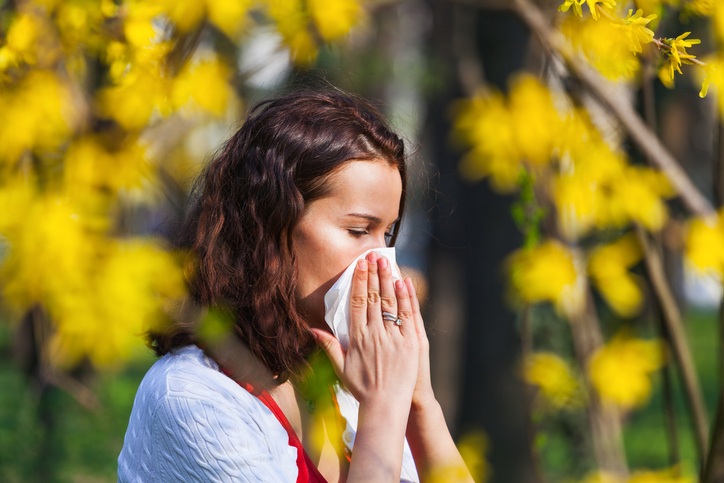- orl-lfuk.sk - Problem with the nasal septum
- orl-lfuk.sk - Nasal polyps
- orl-lfuk.sk - Sinusitis
- orl-lfuk.sk - Enlarged nasopharyngeal tonsil
- healthline.com - What Causes a Stuffy Nose?
- nhs.uk - Catarrh
A full nose: what are the causes of an acutely or chronically stuffy nose?

The feeling of a full and stuffy nose is typical of pollen allergies. Of course, it is also a symptom of sinusitis or nasal inflammation. It is also a symptom of the flu. It is also caused by dry air. It causes difficulty breathing through the nose and generally impairs quality of life.
A full nose due to the environment
The airways, and therefore the nasal cavity, are also affected by the environment. The nasal cavity serves to regulate the air that is inhaled. This refers to its temperature and humidity. In addition, it also serves to trap impurities from the air.
If your nose is full at night or in the morning after waking up, the quality of the surrounding air may be behind this symptom. There is probably low humidity in the room. This results in dryness and swelling of the mucous membranes in the nose, sinuses and a full nose even without mucus or a runny nose.
This is true for overheated or cool rooms with dry air. During the day, this stuffiness will clear up on its own. Also, even the air in air-conditioned rooms is cool and dry. It is necessary to maintain not only the right temperature but also the humidity in the room.
This problem should also be kept in mind if children complain of a stuffy nose at night. Also, the symptom of a runny nose, i.e. the oozing of thick and discoloured mucus, may be absent. Air quality affects a full nose in children at any time, even in babies, i.e. newborns or infants.
A stuffy nose in allergy
If the secretion is clear, watery, it is most often an allergic reaction. This is the case, for example, with hay fever. Sneezing, sneezing, watery eyes, their redness or other manifestations of allergy are also present.
Allergy means hypersensitivity to an otherwise harmless substance or stimulus from the external environment - an allergen. For example, pollen, dust, hair, mites. The immune system of the human organism considers them harmful and reacts with allergy.
A full nose in children, and especially at night, if it is not related to the outflow of colored mucus or an increase in body temperature, signals an allergy. In this case, it may be an allergy to mites, dust or even feathers.
This is also true in the case of adults. When difficulties occur during the day, it is necessary to think about frequent allergies to listed allergens such as pollen, dust and other common allergens in the air.
Hay fever and stuffy nose
Substances that cause allergic reactions are referred to as allergens. Certain specific allergies, such as hay fever, also occur. Hay fever is also referred to as pollen allergy or pollinosis.
In hay fever, pollen and pollen grains are the allergens. Its occurrence is seasonal, during the flowering of flowers, trees and other plants. The pollen of these plants is found in the surrounding air and is carried by the wind even over long distances.

The most common manifestations of hay fever are:
- stuffy nose, swelling of the mucous membranes of the nasal cavity
- sneezing
- increased mucus production
- scratching, itching in the throat
- itchy, burning eyes
- swelling and redness of the eyes
- itching of the ears
- fatigue
- restlessness and nervousness
If the allergic reaction is too intense, there is a risk of anaphylactic shock. In this case, medical help should be sought immediately.
The cause of nasal congestion is a disease
If the nose is blocked with mucous secretions and the mucous membrane is swollen, this is often a respiratory disease.
A stuffy nose is a typical symptom of the common cold, which is the result of inflammation of the nasal cavity lining.
The causes of rhinitis are varied. Non-infectious rhinitis is the most common, it is the already mentioned allergic rhinitis. Non-allergic infectious triggers include, for example, rhinoviruses, adenoviruses, coronavirus.
Non-infectious and non-allergic causes are neurovascular vegetative disorders. They result in increased blood supply to the nasal mucosa, causing swelling and increased mucus production.
If the rhinitis spreads to the sinuses, which are lined with mucous membranes, the sinuses become inflamed. The virus that enters these sinuses from the nasal mucosa damages the mucous membranes in the sinuses. The mucous membranes are more susceptible to bacterial infection.
In this case, the stuffy nose is filled first with watery secretion and later with purulent secretion. Nasopharyngitis can also be accompanied by a stuffy nose. It is a disease that can be both viral and bacterial.
Chronic sinusitis
Chronic sinusitis is inflammation of the sinuses that persists for more than 12 weeks. It can be caused by allergies or inflammation caused by bacteria or fungi. It is a common cause of nasal polyps.
In sinusitis, symptoms such as:
- Increased mucus production, even colored purulent mucus.
- impaired nasal breathing, i.e. a full nose
- impaired sense of smell
- dull pressing pain between and behind the eyes, on the frontal and jaw bones
- sneezing
- itching of the nose
- coughing due to mucus discharge
A common cause of a blocked nose is the flu
A typical seasonal illness is influenza. Influenza is a viral disease and is highly infectious. The risk period for influenza is childhood, chronically ill people.

The main symptoms of influenza include:
- Increase in body temperature to fever (38-40 °C).
- chills, shivering
- sweating
- general weakness, fatigue, malaise
- headache
- pain in joints, muscles, limbs
- runny nose, stuffy and blocked nose
- sore throat
- cough, irritating, dry, choking
- chest pain, especially when coughing
- eye irritation, painful eye movements
- nausea, vomiting and other intestinal forms (including diarrhoea)
- lack of appetite
The period of pregnancy is also risky. In the case of a stuffy nose in pregnancy, it is good to think about the flu as well. The disease itself and its treatment has its own specifications in this period.
TIP: For more information, see the magazine articles Flu in Children and Flu in Pregnancy.
Full nose in other diseases
The feeling of a stuffy or full nose is also found in nasal polyps. Polyps are soft formations, they have an irregular pear-shaped shape. Their color is pinkish or gray.
They most often grow from the lining of the nasal cavities. As they grow, they block the nasal cavity, causing a stuffy nose, impaired and lost sense of smell, mucus accumulation and leakage, sneezing and impaired nasal cleaning.
The sensation of a stuffy nose, especially on one side, is present when the nasal septum bulges. The nasal septum divides the nasal cavity into two halves. When it bulges, breathing problems, blockage, frequent inflammation, olfactory disturbances, pain and sometimes bleeding occur.
Snoring and nasal speech may also be present. In some cases, it is asymptomatic. Nasal septal deviation can be congenital, but also acquired, for example, after an accident.
A stuffy nose is also present when the nasopharyngeal tonsil is enlarged. It is most often found in the childhood period, namely at the age of 3-8 years. The cause of its enlargement is most often frequent inflammation.
Symptoms include impaired breathing, mouth breathing, snoring and gnashing of teeth in sleep. The consequence is also the accumulation of mucus in the nose, its leakage. As a consequence, repeated inflammations of the upper respiratory tract.
TIP: What does a sore throat mean and what is the home method of its treatment.
A full nose is also present as one of the symptoms of childhood measles. In addition to the characteristic rash and increased temperature, they are dangerous in that it is an infectious disease. The latter can attack the respiratory tract, but also the middle ear or brain.

A stuffy nose is also typical of laryngitis, which is an inflammation of the larynx. It manifests itself mainly with a dry cough and sore throat. It is an inflammatory disease. If it is not treated in its acute form, it becomes chronic.
Nasal congestion can also be present in other diseases, such as scarlet fever, infectious mononucleosis and a number of other inflammatory diseases of the upper respiratory tract.
Topically applied drops or sprays are used in the treatment of nasal congestion. The recommended dosage should be followed when using them. Otherwise, there is a risk of developing a habit.
Diseases with symptom "Full Nose"
- Adenovirus infection
- Allergies
- Anaphylactic shock
- Angina tonsillitis
- Bronchitis
- Coronavirus - COVID-19
- Hay fever
- Infectious Mononucleosis
- Inflammation of the nasopharynx - pharyngitis
- Laryngitis
- Measles
- Zarděnky
- Sinusitis
- The common cold
- Cystic fibrosis
- Diphtheria
- Histamine intolerance
- Influenza
- Whooping Cough
Herbs used forFull nose
Interesting resources










